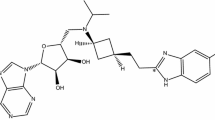Summary
Quinidine and one of its major metabolites, quinidine-N-oxide, were given by separate i.v. infusions to each of three beagle dogs. Plasma and urine samples were analysed for pharmacokinetic comparison of the drug and its metabolite. Quinidine apparently distributed into two major compartments, while the N-oxide distributed into three compartments. The compartment-independent pharmacokinetic parameters (mean ± SD) were for quinidine Vdss 4.78±1.1 l/kg, clearance 0.074±0.047 l/min, terminal half-life 720±343 min and for quinidine-N-oxide Vdss 1.03±0.21 l/kg, clearance 0.065±0.012 l/min, terminal half-life 316±69 min. Only 29% of quinidine was recovered in the urine as unchanged drug while 77% of the N-oxide was excreted unchanged via the kidney. Non-linear renal elimination of the N-oxide was observed in two out of three dogs with a Michaelis-Menten constant, KM of about 7 μg/ml (21 μM).
Prolongation of the QT-interval in the ECG response was used for comparing pharmacodynamic effects. Quinidine was about three to four fold more active than the N-oxide at similar plasma concentrations. Quinidine-N-oxide concentrations in plasma after quinidine administration were very low and would not contribute significantly to the quinidine effect.
Similar content being viewed by others
References
Holford N.H.G., Coates P.E., Guentert T.W., Riegelman S. and Sheiner L.B. (1981): The effect of quinidine and its metabolites on the electrocardiogram and systolic intervals. Br. J. Clin. Pharmac.,11, 187–195.
Drayer D.E., Lowenthal D.T., Restivo K.M., Schwartz A., Cook C.E. and Reidenberg M.M. (1978): Steady-state serum levels of quinidine and active quinidine metabolites in cardiac patients with varying degrees of renal function. Clin. Pharmac. Ther.,24, 31–39.
Guentert T.W., Daly J.J. and Riegelman S. (1982): Isolation and identification of a new quinidine metabolite. Eur. J. Drug Metab. Pharmacokin.,7, 31–38.
Guentert T.W., Rakhit A., Upton R.A. and Riegelman S. (1980): An integrated approach to measurements of quinidine and metabolites in biological fluids. J. Chromatogr. (Biomed Appl.),183, 514–518.
AHA Committee on Electrocardiography (1975): Recommendations for standardization of leads and vector-cardiography. Circulation,52, 11–31.
Yeh K.C. and Kwan K.C. (1978): A comparison of numerical integrating algorithms by trapezoidal, Lagrange and spline approximation. J. Pharmacokin. Biopharm.,6, 79–98.
Perrier D. and Mayersohn M. (1982): Noncompartmental determination of the steady-state volume of distribution for any mode of administration. J. Pharm. Sci.,71, 372–373.
Benet L.Z. (1972): General treatment of linear mamillary models with elimination from any compartment as used in pharmacokinetics. J. Pharm. Sci.,61, 536–541.
Bazett H.C. (1920): An analysis of the time relation of electrocardiograms. Heart,7, 353–370.
Holford N.H.G. (1981): “MKMODEL” in H.M. Perry, J.J. Wood, editors: Public procedures notebook. Cambridge, Mass., Bolt Beranek and Newman.
Raub W.F. (1976): “PROPHET” system and resource sharing. Fed. Proc.,33, 2390.
Toretti J., Weiner I.M. and Mudge G.H. (1962): Renal tubular secretion and reabsorption of organic bases in the dog. J. Clin. Invest.,41, 793–804.
Gerhardt R.E., Knouss R.F., Thyrum P.T., Luchi R.J. and Morris J.J. (1969): Quinidine excretion in aciduria and alkaluria. Ann. Intern. Med.,71, 927–933.
Rakhit A., Holford N.H.G., Guentert T.W., Maloney K. and Riegelman S. (1984): Pharmacokinetics of quinidine and three of its metabolites in man. J. Pharmacokin. Biopharm.,12, 1–21.
Author information
Authors and Affiliations
Additional information
This publication is based in part, on the thesis submitted by Dr. A Rakhit to the University of California, San Francisco in partial fulfillment of the requirement for the degree of Doctor of Philosophy.
Professor Sidney Riegelman deceased April 4, 1981.
Rights and permissions
About this article
Cite this article
Rakhit, A., Guentert, T.W., Holford, N.H.G. et al. Pharmacokinetics and pharmacodynamics of quinidine and its metabolite, quinidine-N-oxide, in beagle dogs. European Journal of Drug Metabolism and Pharmacokinetics 9, 315–324 (1984). https://doi.org/10.1007/BF03189683
Received:
Issue Date:
DOI: https://doi.org/10.1007/BF03189683




